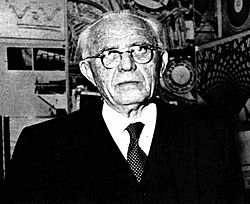Pier Luigi Nervi facts for kids
Quick facts for kids
Pier Luigi Nervi
|
|
|---|---|

Pier Luigi Nervi
|
|
| Born | 21 June 1891 Sondrio, Italy
|
| Died | 9 January 1979 (aged 87) Rome, Italy
|
| Education | University of Bologna |
| Occupation | Engineer |
| Engineering career | |
| Discipline | Structural engineer, architect |
| Institutions | Society for Concrete Construction Institution of Structural Engineers |
| Projects | Olympic Stadium in Rome (1960) UNESCO headquarters in Paris (1950) Hangar in Orvieto (1935) |
| Awards | IStructE Gold Medal Wilhelm Exner Medal (1957) AIA Gold Medal (1964) |
Pier Luigi Nervi was a famous Italian engineer and architect. He was born on June 21, 1891, and passed away on January 9, 1979. He taught engineering at Rome University and was known for using reinforced concrete in new and exciting ways. He especially liked creating strong, thin, curved structures.
Contents
About Pier Luigi Nervi
Pier Luigi Nervi was born in Sondrio, Italy. He studied civil engineering at the University of Bologna and finished his studies in 1913. After graduating, he joined a company that worked with concrete. During World War I, from 1915 to 1918, he served in the Italian Army's engineering group. Later in his career, from 1961 to 1962, he was a visiting professor at Harvard University in the United States.
Amazing Engineering Projects
Nervi started working as a civil engineer after 1923. In the 1930s, he designed several airplane hangars. These buildings were important for his growth as an engineer. For example, some hangars in Orvieto (built in 1935) were made completely from reinforced concrete. He later improved his designs for hangars in Orbetello and Torre del Lago (1939). These new hangars had lighter roofs and used parts that were made in advance, making them easier to build.
In the 1940s, Nervi developed new ideas for reinforced concrete. This helped rebuild many buildings and factories in Europe after the war. He even designed a boat hull made of reinforced concrete to show how strong and useful the material was.
Nervi believed that engineers should use their intuition and creativity as much as math when designing. He was especially good at designing thin, curved structures. He took ideas from ancient Roman architecture and the Renaissance. He used ribs and arches to make structures stronger and remove the need for many columns. He combined simple shapes and prefabrication (making parts beforehand) to create new design solutions.
Engineer and Architect Skills
In Italy, Nervi was trained as a "building engineer," which meant he could also be considered an architect. After 1932, his designs became very popular for large projects. This was because many new buildings were being constructed in Europe using concrete and steel. Nervi successfully made reinforced concrete a main material for building at that time. He shared his ideas about building in four books and many papers.
Nervi's work was also part of the art competition at the 1936 Summer Olympics in 1936.
International Buildings
Most of Nervi's buildings are in his home country of Italy. However, he also worked on projects in other countries. His first project in the United States was the George Washington Bridge Bus Station in New York City. He designed the roof, which was made of triangular pieces cast right there. This building is still used today by many buses and passengers.
Famous Buildings and Designs
Here are some of Pier Luigi Nervi's most famous works:
- Stadio Artemio Franchi, Florence, Italy (1931)
- Ugolino Golf House, Impruneta, Italy (1934)
- Torino Esposizioni, Turin, Italy (1949)
- UNESCO headquarters, Paris, France (1950)
- The Pirelli Tower, Milan, Italy (1950)
- Palazzo dello sport EUR, Rome, Italy (1956)
- Palazzetto dello sport, Rome, Italy (1958)
- Stadio Flaminio, Rome, Italy (1957)
- Palazzo del Lavoro, Turin, Italy (1961)
- Palazzetto dello sport, Turin, Italy (1961)
- Australia Square tower building, Sydney, Australia (1961 - 1967)
- Sacro Cuore (Bell Tower), Florence, Italy (1962)
- Paper Mill, Mantua, Italy (1962)
- George Washington Bridge Bus Station, New York City, USA (1963)
- Tour de la Bourse, Montreal, Canada (1964)
- Leverone Field House at Dartmouth College, USA
- Sede Centrale della Banca del Monte di Parma, Parma, Italy (1968)
- Edmund Barton Building, Canberra, Australia (1970)
- MLC Centre, Sydney, Australia (1973)
- Thompson Arena at Dartmouth College, USA (1973 - 1974)
- Cathedral of Saint Mary of the Assumption, San Francisco, California, USA (1967)
- Paul VI Audience Hall, Vatican City (1971)
- Chrysler Hall, & Norfolk Scope Arena in Norfolk, Virginia, USA (1971)
- Australian Embassy, Paris, France (1973)
- Good Hope Centre, Cape Town, South Africa (1976)
Awards and Recognition
Pier Luigi Nervi received many important awards for his work. He was given Gold Medals by the Institution of Structural Engineers in the UK, the American Institute of Architects (AIA Gold Medal 1964), and the RIBA. In 1957, he also received the Frank P. Brown Medal and the Wilhelm Exner Medal.
Images for kids
See also
 In Spanish: Pier Luigi Nervi para niños
In Spanish: Pier Luigi Nervi para niños
- Thin-shell structure






